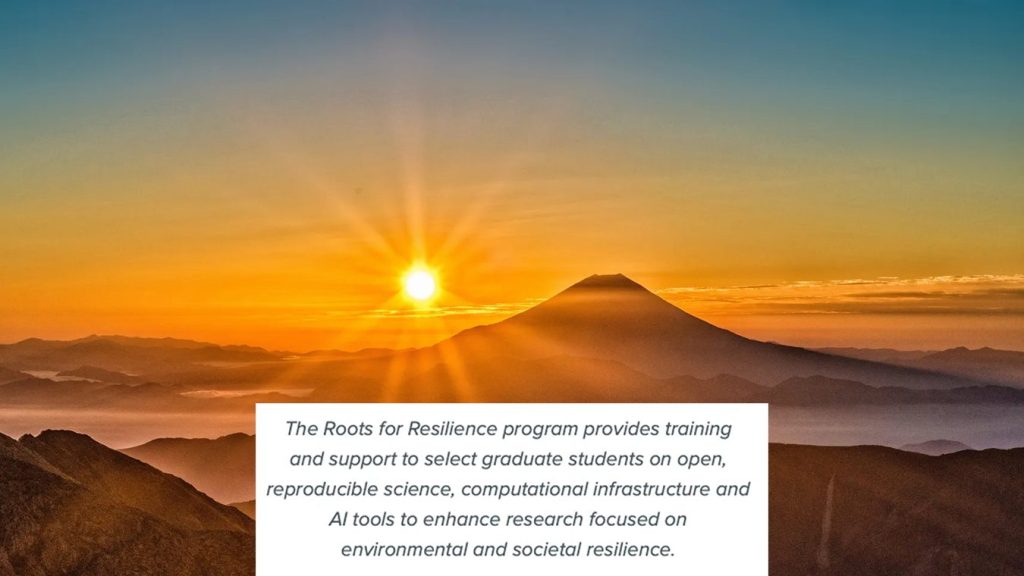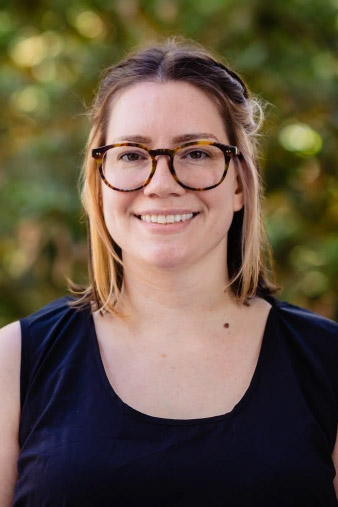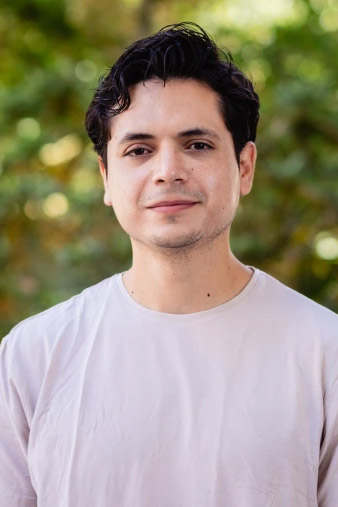Graduate art students Lori Hennessy and Andrés Cabellero joined the “Roots for Resilience” cohort to build capacity in data science and AI skills at the University of Arizona.
The 13-person cohort will learn best practices in open science, computational infrastructure, and artificial intelligence for research and discovery. The initiative aims to increase the University of Arizona’s research capacity in environmental and societal resilience.
Fellows, who receive a $7,000 stipend, attend two weekly sessions during fall semester learning Foundational Open Science Skills. Each Fellow will deliver two presentations by the end of the semester. Upon completing R4R, cohort fellows serve as departmental ambassadors, sharing the valuable knowledge gained from the program.
- Lori Hennessy, School of Music
Third-year Doctor of Musical Arts candidate
- Andres Caballero, School of Art
Final-year MFA candidate in Photography, Video & Imaging
The Technology and Research Initiative Fund (TRIF) funds this program and the Data Science Institute (DSI), CyVerse, and Arizona Institute for Resilience (AIR) administers it.

Lori Hennessy // School of Music
Lori Hennessy, a third-year Doctor of Musical Arts student in cello performance, views the program as a chance to bring innovation to a field not often associated with technology.

“I appreciate the idea of learning how AI skills can enhance my research,” she said. “I think in a field like mine, classical music performance, we’re not always on the cutting edge of such technology. This is a good opportunity to learn things that I could not only use in my own research but also could help others of my field.”
Hennessy, who studied cello performance and Suzuki pedagogy at the Cleveland Institute of Music, spent a decade teaching in the San Francisco Bay Area before joining the University of Arizona as a University Fellow. She has performed with the Graduate String Ensemble and recently won the School of Music’s concerto competition, performing Beethoven’s Triple Concerto at the 2025 President’s Concert.
Her academic research uses process tracing, a data-driven method of analyzing how major events shape outcomes over time. She’s looking at large-scale social shifts, like the change of arts funding in the 20th century or how women entered the workforce and became music educators. She hoping that AI can help her organize huge amounts of information and identify trends.
“This is a good opportunity to learn”
“I’m hoping to use the AI for is helping me organize the bigger picture and then I can spend my time hopefully in a way that’s the most useful.”
Hennessy said she hopes to show other students how these tools can expand creative inquiry. “When I give my presentation, it’s going to be tailored to artists, people in the humanities, and I can show them why this field in general is helpful and interesting but also show them specifically how we can use these tools to relate to what we do and the type of research we’re doing.”
Andrés Caballero // School of Art
Andrés Caballero, a final-year MFA candidate in Photography, Video & Imaging, explores the complex realities of migration, surveillance, and marginalization across the U.S.–Mexico border. His work questions how visual technologies shape power and perception — and how they can be reclaimed for social justice.
This is the first time an arts student has participated in this program.

“Having someone from the School of Art is not as common, but I think the arts can add to the conversation with people from other departments. They are training the cohort with several tools such as AI, deep learning, the use of CyVerse (a free university resource for data storage and analysis), and open science tools.”
Then each person from the cohort becomes a spokesperson in their own department.
“I’m very interested in giving this talk to the MFA students because … all of these tools … are free, and they are not that complicated to use. And hopefully, at least one or two of the art students become interested enough that they can apply them for their own research.”
Caballero said he’s still discovering how to collaborate with AI directly for his art practice.
“AI is going to change everything”
“I think we have to accept that AI is going to change everything, even our perception of reality. So, we have to understand how it works. My research is about how these technologies are being used at the US/Mexico border targeting in particular vulnerable populations.”
He also sees AI as a way to critique the very systems that create it.
“Using AI and analyzing their data sets can illustrate how they function, what are their biases and flaws, basically how they perceive the world. I think it’s important to learn about these systems in order to look at where we are heading.”
“On the other hand, there is a way of collaborating in a responsible manner with these tools in order to make your art practice much more efficient. We have access to apps and software that we didn’t have five years ago. And now artists can also use that technology; ideally incorporated into a socially engaged project that can become part of a larger discussion.”
